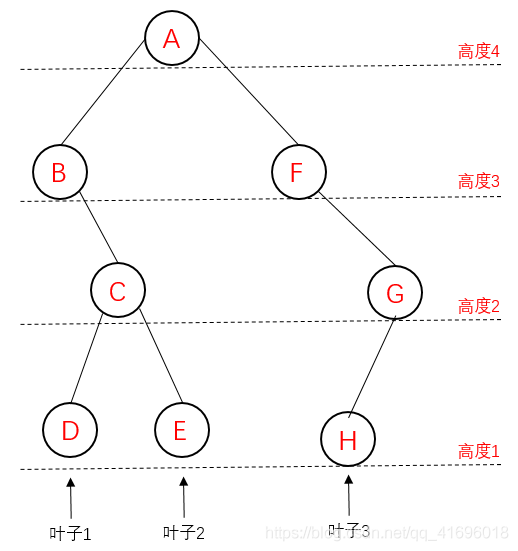本篇参考求二叉树叶子数与高度(C++)进行整理。
文章目录
- 1. 二叉树中叶子数与高度
- 2. 求二叉树叶子数与高度的实现代码
1. 二叉树中叶子数与高度
我们首先来看一看二叉树中叶子数与高度的定义:
-
叶子数:对于一个二叉树的节点,若其既没有左子树又没有右子树,那它就是叶子节点。整个二叉树的叶子数为所有叶子节点个数。 -
高度:二叉树高度又称深度,其为根节点到叶子节点路径的最大值。

2. 求二叉树叶子数与高度的实现代码
求二叉树叶子数与高度均采用递归的方法,其基本操作方法都比较类似,具体实现代码如下:
#include <iostream>
using namespace std;
//定义二叉树节点
class binarynode
{
public:char data; //节点数据域binarynode* lchild; //左孩子binarynode* rchild; //右孩子
};
//求树高度
int getheight(binarynode *root)
{if (root == NULL){return 0;}//求左子树高度int lheight = getheight(root->lchild);//求右子树高度int rheight = getheight(root->rchild);//当前节点高度int height = lheight > rheight ? lheight + 1 : rheight + 1;;return height;
}
//求叶子节点,采用递归方法
void calculateleafnum(binarynode* root, int* leafnum)
{if (root == NULL){return;}if (root->rchild == NULL && root->lchild == NULL){(*leafnum)++;}//左子树节点数目calculateleafnum(root->lchild, leafnum);//右子树节点数目calculateleafnum(root->rchild, leafnum);
}
//创建二叉树
void createtree()
{//创建节点binarynode node1 = { 'A',NULL,NULL };binarynode node2 = { 'B',NULL,NULL };binarynode node3 = { 'C',NULL,NULL };binarynode node4 = { 'D',NULL,NULL };binarynode node5 = { 'E',NULL,NULL };binarynode node6 = { 'F',NULL,NULL };binarynode node7 = { 'G',NULL,NULL };binarynode node8 = { 'H',NULL,NULL };//建立节点关系node1.lchild = &node2;node1.rchild = &node6;node2.rchild = &node3;node3.lchild = &node4;node3.rchild = &node5;node6.rchild = &node7;node7.lchild = &node8;//计算二叉树高度int height = getheight(&node1);cout << "二叉树的高度为:" << height << endl;//计算二叉树叶子数int num = 0;calculateleafnum(&node1, &num);cout << "二叉树的节点为:" << num << endl;
}int main()
{createtree();system("pause");return 0;
}运行结果:

- 求二叉树叶子数与高度



 用法教程)

HandlerExceptionResolver启动和异常处理源码分析)


)







进阶环形链表(2)及环形链表的约瑟夫问题)


